Your one stop location for photos of anything nature. Nature Photography galore! Nature Pictures by David Webb Photography include images of flowers, flora, fauna, macro, beach, Australian landscapes, Australian culture, Photography Tips and more.
Monday 31 December 2007
Monday 24 December 2007
Merry Christmas!
In my last post I asked you all what photo you would like as a Christmas gift. I have received quite a few varied responses, so thank you all for your feedback. In this post I've included two of the requests. A Merry Christmas to you all, and may you have a fruitful and happy New Year in 2008!




Saturday 22 December 2007
Purple Garden Flowers - Purple Sunday
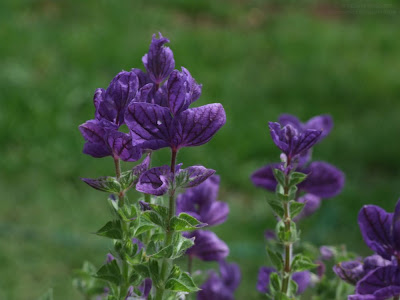
Here we are at the last Purple Sunday in Advent. It's now only two days until Christmas, and the celebrations are already beginning. These next few days are an exciting time, especially for children, and we reach a culmination point on Christmas day, when gifts are exchanged and presents unwrapped, and everyone can feel the joy of the season. Although we don't get to see Santa riding through the snow here in Australia, we do get to enjoy all the colours and life of Summer in full bloom.
The flowers in this picture are a garden variety grown in the Spring to add a bit of colour to the area. Right now they are flowering profusely, probably helped by the recent rain, allowing me to capture this shot of a group of them growing together. As always, I would greatly appreciate it if anyone can identify the flowers, as I bought these in a "colour mix" packet of seeds and therfore don't know what they're called.
And now, I would like to set a question to you:
What would you like to see a photo of on this blog for Christmas?
Keep in mind that it's Summer here, so I'm not going to be able to get and winter-like shots, but send in your suggestions and I'll try to get a photo as a Christmas present for you all!
This photo taken with the Fujifilm S9600 digital camera.
Shutter speed: 1/340, F5.7, ISO 100
Wednesday 19 December 2007
Sun shining through leaves at Sunset - Wordless Wednesday
This photo taken with the Fujifilm S9600 digital camera.
Shutter speed: 1/350, F4.1, ISO 200
Sunday 16 December 2007
Pink Tulip Flower - "Purple" Sunday

Now for the surprise.......
Yes, you read it right. Pink Tulip flower. Not Purple. Well, I said I had a surprise in store for this Sunday. This Sunday is not actually Purple! As the wikipedia article about Advent says: "On the 3rd Sunday of Advent, Gaudete Sunday, a rose [colour] is used since this Sunday takes on a more joyous tone." So, this being the 3rd "Purple" Sunday, I have a pink, or rose coloured picture for you today.
I got this photo of a pink Tulip blossom at a flower festival earlier this year. We were just entering Spring at the time, and you can see many other brightly coloured flowers in the background of this picture. I used a low aperture (F4.3) while taking this photo to ensure that the flower remained in focus while the background was blurred. I think this is actually a "Tulipa Purple Prince" flower, but it looks pink to me! Please tell me if you know the proper name of this flower, it would be a great help.
This photo taken with the Fujifilm S9600 digital camera.
Shutter speed: 1/120, F4.3, ISO 200
Wednesday 12 December 2007
The Colors in the End of a Rainbow - Wordless Wednesday
This photo taken with the Fujifilm S9600 digital camera.
Shutter speed: 1/140, F4.9, ISO 800
Sunday 9 December 2007
Purple Weed (Wildflower) - Purple Sunday
This picture has an interesting pattern of drawing your eyes between the flowers themselves, and the base of the stem. The radiating stems then send your eyes back to the top of the picture again. Try it - it's amazing how much these little things affect the composition of the picture.
This photo taken with the Fujifilm S9600 digital camera.
Shutter speed: 1/450, F3.7, ISO 100
Wednesday 5 December 2007
Australian Kookaburra - Wordless Wednesday
This photo taken with the Fujifilm S9600 digital camera.
Shutter speed: 1/350, F7.2, ISO 100
Sunday 2 December 2007
Agapantha Flower - Purple Sunday
In keeping with this tradition, I have chosen the purple Agapantha (agapanthus africanus) flower for today's post. Last month you saw an unopened bud, but today the flower is fully open and blooming. The stamen are clearly visible, and the small yellow bunches of pollen at their tip are sharply in focus. The green stems in the background also provide a contrasting relief from the soft purple and white of the petals.
As we enter Summer here in Australia, and America enters Winter, everyone is preparing for Christmas. But I hope that amongst your shopping and decorating, you can also take time to experience the "joy" of the season, and have a look at the wonder of nature around you.
This photo taken with the Fujifilm S9600 digital camera.
Shutter speed: 1/89, F8.0, ISO 100
Friday 30 November 2007
Lettuce Leaf - Fractals in Nature
This photo taken with the Fujifilm S9600 digital camera.
Shutter speed: 1/28, F3.9, ISO 100
Wednesday 28 November 2007
Wednesday 21 November 2007
Daisy Flower Close Up - Wordless Wednesday
This photo taken with the Fujifilm S9600 digital camera.
Shutter speed 1/30, F8.0, ISO 200
Saturday 17 November 2007
Urban Landcape - Sunset, Sun-rays, and Clouds

Last night I was outside during twilight, and noticed this amazing sunset. The Sun has already disappeared behind the clouds, but rays of light are still shining out and covering the sky. Although the photo above might look touched-up, I have not digitally manipulated this picture. The duotone effect (where the sun and it's rays are black-and-white while the sky near the top of the picture is blue) simply occurred naturally. This is a capture which is not likely to be seen again soon, I was lucky to be out at the right time to see it.
The photo below is of the same scene taken a few minutes later - you can see the huge difference between the pictures. In the photo below, the sun has set and the rays of light from the first picture are entirely gone, replaced instead by a reddish glow near the horizon.
 Sunsets are always very beautiful to watch, and each one is different. As you can see from these photos, the scene changes even from minute to minute, giving you a very entertaining show. So why not step outside tonight, and have a look at this wonderful "theatre" of creation, free for all to see?
Sunsets are always very beautiful to watch, and each one is different. As you can see from these photos, the scene changes even from minute to minute, giving you a very entertaining show. So why not step outside tonight, and have a look at this wonderful "theatre" of creation, free for all to see?These photos taken with the Fujifilm S9600 digital camera.
#1: (Sun with Rays Shining) Shutter speed: 1/5999, F8.0, ISO 80
#2 (Sunset over rooftops) Shutter speed: 1/399, F5.7, ISO 100
Monday 12 November 2007
Purple Agapantha Flower (Agapanthus africanus)
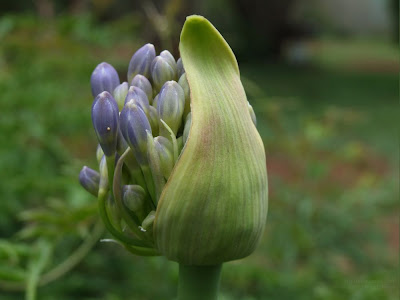
As it's Spring time here in Australia, all the flowers are blossoming and the trees are growing fruit. One of the variety of flowers blooming here at the moment is the Agapantha flower, properly called the Agapanthus africanus. These purple flowers are just starting to bud - when they have opened they will turn into a loosely hanging bunch of bright purple blossoms.
The photo shown above depicts an agapantha flower that is just beginning to blossom - the left half has started to unfold while the right section is still a bud. The green of the flower blend in with the green grass in the background, and contrasts nicely with the purple blossoms just beginning to peek out of the flower. A this photo was taken with an aperture of F4.9, the background remains out of focus, thus keeping the attention drawn to the flower itself.
It was overcast when I took this photo, so the picture has a very soft look to it. There was still enough sunlight available for me to avoid using a tripod, but there weren't any hard shadows on the underside of the flower - perfect lighting conditions. I'll try to track this flower for you and get some pictures of it when it's fully developed - in the meantime you might want to check out last Summer's agapantha shots.
This photo taken with the Fujifilm S9600 digital camera.
Shutter speed 1/280, F4.9, ISO 100
Saturday 10 November 2007
Lighting Striking Dead Tree

The other night we had a big thunderstorm with lightning over here, so naturally I was out with the camera in the cold and wet while others were inside snug and warm. Actually, I wasn't so foolish as to bring the camera outside during the rain, but after the storm passed over I went out looking for lightning shots. I took a few 30-second exposures, but the noise even at ISO 80 was disappointing. Decreasing the shutter speed by increments, eventually I got down to a 2-second exposure at ISO 80. Now for lightning, there's not much chance of getting a good shot with only a 2-second exposure. But I tried anyway. And what turned out was amazing...
It was a one in a million chance. During the second exposure, a huge bolt of lightning split the sky - directly in the middle of the frame. And this is how it turned out. I find it amazing that I was able to get such a good shot on just the second try. The lightning is streaking through the darkened sky, ending in a flash of electricity near the ground. A dead tree stands in stark silhouette against the backdrop of dark purple clouds. The pitch black of the surrounding terrain serves to intensify the scene, as well as provide a natural frame for the action.
It just goes to show: don't rely on the tried and tested methods, do something different and strange - it might just work out!
Saturday 27 October 2007
Dainty Birdwing Butterfly

When I was walking down the street at Boreen Point (near Noosa) I spotted this butterfly resting in the Sun. It didn't seem to be moving, and presented the perfect opportunity for a photo. Butterflies are normally very hard to get on camera, as they fly all over the place only stopping for about 5 seconds at a time. This butterfly proved the exception however, and stayed still calmly while I got some close-up shots.
This photo taken with the Fujifilm S9600 digital camera.
Shutter speed 1/149, F3.7, ISO 100
Thursday 25 October 2007
Question: Have you ever Ego-Googled?
My answer to this: Certainly. I think that just about everyone who uses the internet frequently is overcome by the desire to find themselves in the vast realms of cyberspace. But for most people, the answer to the following question will be the same as mine:
Did you find anything?: No
Of course not all of us are famous, so we may not be within the first 30,000 odd pages of a Google search for our name. This really depends on how obscure your name is. When I Google my fake name which I sometimes use for dubious registration forms, I am at the top of the list. That is because nobody famous has that name. However, in a search for "David Webb", I'm nowhere.
What about you? Have you ever Googled yourself? If you want to answer this question, I encourage you to vote using the poll on the right hand side of this page. Next week we'll see how the votes fall - so keep posted!
Update: I have recieved a lot of feedback on this post, and everybody who has commented has pretty much the same story as me: they have Googled themselves, but they usually don't rank very high, if at all. This concludes the question - most people have Googled themseleves.
Wednesday 24 October 2007
New Life - Green Leaves with Sun Shining
Saturday 20 October 2007
Giraffe Neck Hairs Close Up

Here's an interesting shot I got at the Dubbo Zoo - a close-up photo of a giraffe's neck, with the hairs and markings clearly visible. You can see that a giraffe does actually have a "mane" so to speak - there is a ridge of longer hairs along the back of the animal's neck.
It's evident from the composition of this shot that "more is not always best" as David McMahon says on his blog. Sometimes you just have to ignore the whole and crop in on a small part of the object to achieve a certain effect. This photo turned out extremely clear and sharp, and seems almost as if you could reach out and touch the rough fur of the giraffe.
This photo taken with the Fujfilm S9600 digital camera.
Shutter Speed 1/340, F7.2, ISO 100
Wednesday 17 October 2007
Thursday 11 October 2007
Emus on the Roam
As I mentioned in the last post, I've recently had the opportunity to visit the Western Plains Zoo in Dubbo, NSW. I took lots of photos (800+), so I've got lots of pics to post on this blog. For the first picture, I've chosen a subject that is uniquely Australian - an Emu.
The Western Plains Zoo has a good setup for photographing the animals. Instead of planting 8-foot fences between the people and animals, there is a sort of moat-and-wall arrangement, where you effectively stand on a mound of earth which puts you level with the top of the fence. This gives you a clear line of sight to the animals, which is great for photos
These emus were quite inquisitive, coming right to the edge of the "fence" to get their photos taken. With 10x zoom, I was able to get some good close-ups of the emus' heads.
The photo above shows a head-on view of the emu, while the photo below portrays the bird from the side. Both of these photos seem to portray a sense of action and alertness, as if the emu is utterly aware of your presence and is waiting for you to make the first move.
Overall the visit to the zoo was a fruitful exercise, and should merit a plethora of new photos for this blog. I look forward to sharing these photos, and I hope you will enjoy them too. I've been playing around with wide-screen photography, and the second emu photo in this post is an example of this. Hopefully I'll be putting up some of my shots in this format, it seem to convey a very different impression to standard 8x10 or 6x4 photography.
Related Photos:
Monday 1 October 2007
Holiday Time!
One of the places I'll be visiting is the Dubbo Zoo. This should be a great opportunity for some animal photos, something that I haven't had a lot of here lately. It's supposed to mimic African scenery, so that's even better.
Remember, while I'm away you could always try browsing through the "label cloud" on the right of the page, or use the search box above it. I've got over 140 photos up here so far, so I hope that's enough to keep you amused while I'm away!
Saturday 29 September 2007
Moon Watching

First, let me tell you one thing - no, I did not use a telescope. A few nights ago I got out with the new camera, stuck it on a tripod, and got some shots of the (nearly) full Moon. When I looked at them on-screen later (and with a bit of cropping), this is what came up! I've never been able to take a photo of the Moon as accurate and detailed as this before, but with the Fujifilm S9600's 10.7x zoom these photos turned out remarkably clear. You can actually see the minute markings and dark patches on the Moon.
I found, however, that using auto-exposure settings resulted in a washed-out Moon, even when I focused the camera on the Moon's radius. I actually had to increase the shutter speed to about 1/320 before the Moon's markings started to become visible. This also helped to make the camera steadier, so I was able to use an ISO setting of just 80.
Later in the week I got up on the roof and shot the photo below. The Moon is framed by the branches of the eucalyptus, or gum tree which fills up most of the frame, and the tree in turn is highlighted by the Moon's light. This photo was taken at dusk, just after the Sun had set.
After trying many times to get good Moon photos I had nearly given up, but this new camera has yet again proved its worth, managing to get some excellent photos of the Moon. My only piece of advice to potential moon-gazers is this - keep your shutters well up!
 These photos taken with the Fujifilm S9600 camera.
These photos taken with the Fujifilm S9600 camera.Photo #1 (Moon Close-up): Shutter speed 1/319, F4.9, ISO 80
Photo #2 (Moon behind tree): Shutter speed 1/60, F4.9, ISO 100
Friday 28 September 2007
5,000 A.D. - Beginning a new Millenium
Time of Visit Sep 28 2007 9:23:54 am
Last Page View Sep 28 2007 9:24:43 am
Visit Length 49 seconds
Page Views 3
Referring URL http://www.google.com.au/search?q=heart tomatoes&hl=en
Search Engine google.com.au
Search Words bullock heart tomatoes
According to Google Analytics I've actually had 6,103 visits, but I'll use the sitemeter count for this post. Here is a graph of all the traffic to this blog so far this year:
 As you can see, I've had a great increase in blog traffic over the past few weeks. Now I'm going to have to stop posting about every 1,000 visits, because at this rate I should get about 1,600 per month!
As you can see, I've had a great increase in blog traffic over the past few weeks. Now I'm going to have to stop posting about every 1,000 visits, because at this rate I should get about 1,600 per month!But it's not just the traffic that counts. As you will know if you have a blog yourself, the visitor loyalty is one of the key factors to ascertaining a blog's success. According to Google Analytics, about 5% of the visitors to this blog have returned 2 or more times. I think that's pretty good for 5,000 visitors - approximately 50 people have demonstrated some interest in the blog.
It's interesting to note the most popular search queries for this past year:
 As you can see, my agapantha flowers post seems to be very popular, but overall people tend to come here looking for nature photography.
As you can see, my agapantha flowers post seems to be very popular, but overall people tend to come here looking for nature photography.Finally, I would like to thank all the people who have visited and commented on this site, especially those who have subscribed. Running this blog has been a great experience so far, and I hope that you and many other readers will continue to enjoy it into the future.
Saturday 22 September 2007
Bird of Paradise Flower - The Onset of Spring
Yesterday afternoon I went for a visit to one of the local parks. The flowers there are in full bloom and provide great opportunities for macro shots. In that 2-hour session alone I took nearly 200 photos! Thankfully the era of digital cameras has alleviated the need for film, otherwise that session would have cost quite a bit.
This bird of paradise flower is one of the hugely diverse species of flora to be found in the park I visited yesterday. I took this photo just before sunset, when the sun's rays shining through the flower give it a bright and intense colour, and highlight the "flame-like" crest of the flower. In the background, you can see another dead flower, which mirrors this one, starkly contrasting with its vigorous life.
So far the photos I've got of this Spring have been mostly close-up, or macro shots, as the landscapes aren't quite out of Winter yet. But never fear, as soon as the landscapes come you'll be seeing them. At the moment I'm working on a photo-sequence showing the opening of flowers, so expect to see the results of that soon. In the meantime, sit back and enjoy Spring - mozzies and all!
(N.B. For the majority of my readers who are American, I'll be posting some more Spring-ish photos soon, so don't worry, you can enjoy it too, but without the mozzies (or mosquitoes in your language!))
This photo taken with the Fujifilm S9600 digital camera.
Shutter speed 1/124, F4.9, ISO 200
Related Photos:
After the Rain - Jasmine Flowers
The Blossom of the Pond (Water Lily Flower)
Sunflower close-up
Balloon Vine Flower (with water droplets)
Balloon Vine Flower (without water droplets)
Saturday 15 September 2007
After the Rain Part 1 - Jasmine Flowers


These photos all show jasmine flowers at their various stages of development. The Fujifilm S9600's super macro mode helped here to get really close up shots. The two pictures on the left hand side show water droplets hanging off jasmine buds, while the photos on the right show fully opened jasmine flowers.


These photos taken with the Fujifilm S9600 digital camera.
Friday 7 September 2007
Bumble Bees in Motion
I've included two of the best bee photos here. The first one (above) shows a bee hovering in the air mid-flight, about to land on a yellow Pak Choy Flower. You can actually see the bee's wings as they flap through the air at top speed.
In the second photo (below) the bee has landed and is sucking the pollen from the flower. Notice the large yellow pollen sac at the middle of the bee's body. Again, the yellow flowers are from a Pak Choy plant.

So far my experiences with the Fujifilm S9600 have shown it to be well worth the money. It certainly has exceptional macro capabilities, and it's great to have full manual control over the shutter speed and aperture settings. I'm looking forward to lot's more great photos in the months to come, and I hope you too can share in the enjoyment of this "wonderland of nature".
Coming up: After the Rain....
These photos taken with the Fujifilm S9600 camera.
Shutter speed 1/399, F5.7 (#1) & f7.2 (#2), ISO 200
Related Photos:
Bee landing on Lavender Flower
Life on a smaller scale [Mushrooms in Grass]
Close-up of yellow Pak Choy Flowers
4000 A.D.
Statistics:
Most popular search term: hairy caterpillars.
Average visit length: 3 minutes 47 seconds.
Average pages viewed per visit: 1.58.
Most popular page: The Sunflower that's not a sunflower.
I would like to thank all those who have contributed to this blog either directly or by giving feedback by comments or emails. It is great to share the wonder of nature with other people through the medium of the internet and photography. Thank you all for you support!
Wednesday 5 September 2007
New Camera! [Fujifilm S9600]
Yesterday I bought a new camera to replace the 4.0MP Kodak C330 that has served me faithfully for the last two years. Although I wasn't quite ready to make the jump to a (d)SLR, the model I selected has full manual features and most of the benefits of an SLR.
Today I'll be playing with the new camera a bit, so expect to see some new photos any time now. After I've used the Fujifilm for a while I'll also try to post a review with the real life Pros and Cons of the camera, so keep an eye out for that later.
Overall I'm quite impressed with the quality of the Fujifilm S9600. It's raining here at the moment, and you know how good nature photography looks after the rain, so expect a treat, coming soon....
Sunday 2 September 2007
Labeling the Clouds
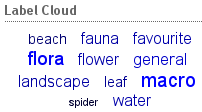 Basically, this "cloud" is just a list of all the photographic categories in this blog, but with a twist - the categories with more posts in them appear bigger in the list, while the less populated categories show up smaller.
Basically, this "cloud" is just a list of all the photographic categories in this blog, but with a twist - the categories with more posts in them appear bigger in the list, while the less populated categories show up smaller.I hope that this new addition, along with the content rating system at the bottom of every post will help you to enjoy this blog more. So have a browse! Just click on one of the categories on the right to get started. And if you like a post, you can give it a rating simply by selecting your choice on the bar at the bottom of the post.
Tuesday 28 August 2007
Amazing Grace - The Splendour of Light [Sun bursting through clouds]

Sun bursting through clouds
Recently I watched the movie “Amazing Grace”, an excellent movie about the abolishment of the slave trade in 18th century England. It follows the political work of William Wilberforce, a politician in the House of Commons. This photo reminds me of the theme of the movie – through all evils and tribulations of this world, God and goodness will triumph. The bright Sun, shrouded by cloud, seems to be bursting forth from its corner of the sky, spreading the Light to all corners of the globe.
This photo gains its impressive and triumphant effect mainly because of the parabolic nature of the image – the picture seems to have been taken with a “fish eye” lens, creating an effect of bulging in the centre. Surprisingly, I took this photo with a simple point-and-shoot Kodak C330 digital camera, and didn’t use a fish eye lens at all!
The trees in this photo create a natural frame for the picture. The gum tree (eucalyptus) is slightly offset from the left edge of the photo, so your eye tends to be drawn towards the left hand side of the picture.
On the whole, this picture conveys a sense of suspended movement and the glorious splendour of light. This picture, with its symbolism of light and goodness, is a reminder to us all to have hope for the triumph of good over evil.
This photo taken with the Kodak C330 digital camera.
Related Photos:
Dry Australian Landscape - the Aussie Bliss
Morning Sun
Sunset Vista
Sunday 19 August 2007
Life on a smaller scale [Mushrooms in Grass]


These two small groups of mushrooms are the type that spring up immediately after some rain, and then disappear as quickly as they came. Although we have had a lot of rain here lately, I actually took these photos a few years ago when the Kodak C330 was new. These photos depict two different types of mushroom, one group short with a slight brownish tint to their "caps", or "heads", and the other tall and thin, with flatter, white caps. I think this photo conveys a sense of silent, stealthy growth - the mushrooms appear to be "still life", but all the while they are quietly growing underfoot.
The first of these two photos has the popular "bi-focal" arrangement - two major subjects dominate the picture, complementing each other and providing an interesting field in which the eye can play. On the left, we have the tight bunch of 4 small mushrooms, while on the right a sprig of grass splays out, leading our eyes in the opposite direction.
In the second photo, the mushrooms seem to be straining upwards, as if they aren't content with their meager height and wish to lift to more lofty realms. The grass too seems to be following it, pointing skywards, following the lead of it's overshadowing companions. The green grass and pale white stems of the mushrooms contrast sharply, and bring an extra aspect to an otherwise monotonous image.
Both these pictures share a common theme, of still life, of nature, of minute activity in the undergrowth. Most of all, they demonstrate the wonder of God's creation, yet again, and remind us humans that we are not the only living things on this earth.
This photo taken with the Kodak C330 camera.
Sunday 12 August 2007
Lazy Sunday [Bearded Dragon Lizard]

Recently I was walking around a friend's property, mostly Australian semi-rural bushland, when I came across this little creature. Although he looks frightening, the Bearded Dragon lizard is practically harmless, and refused to move a muscle even when we picked him up! Before moving him, I snapped this shot at an unusual angle. The detail in this photo is amazing when viewed full-screen, especially around the lizard's head - you can see every small spike and inflection in his scaly skin. Although, as I said, these lizards are practically harmless, they can give you a nasty bite if provoked, so don't go picking them up!
This shot really makes you think. Whenever anybody looks at this picture they tend to automatically tilt their head counter-clockwise 90 degrees and look up and down the lizard's body. That's because of the unusual composition and depth of field in this photo.
The Bearded Dragon's head forms the primary focus-point in the image, with the beady eye attracting attention at the top of the head, and the split bark of the log leading the eye towards the dragon's frill further down.
I think the strangest thing about this photo is that you keep trying to turn sideways to look the lizard in the eye. The way the log and lizard combine to create an interesting "tilt" to the image helps to attract attention and create uniqueness. Just don't look at this picture too long - you might permanently bend your neck!
This photo taken with the Kodak C330 digital camera.
Related Photos:
A Hen-pecked Chook's Feathers
Another Hairy Caterpillar Photo
Prawns, Anyone? (Prawn Heads)
Saturday 4 August 2007
The Blossom of the Pond [Water Lily Flower]

This Water Lily blossom is yet another example of nature's wondrous beauty. As with all flowers of this sort, the soft pink petals seem to serve as a showcase for the bright yellow center of the flower. Each petal has a delicate adornment of water droplets which help to bring time and depth to the photo. The background of lily-pads help show the close-up nature of the image. This photo was taken at Singleton, NSW, Australia. It shows a completely different aspect of Australia's natural heritage than the Dry Landscape shown before.
This photo is really just a point-and-shoot picture - there are no special compositional techniques used, no fancy aperture or shutter-speed adjustments, just a simple fill-the-frame photo from about 15cm away. The only noteworthy aspect of this photo's composition is the familiar "concentric focus" theme coming through again - the main curves in the picture converge on the central subject of the image.
This photo taken with the Kodak C330 digital camera.
Related Photos:
Sunflower Close-up
Balloon Vine Flower with Water Droplets
Soft-focus Flower
Wednesday 1 August 2007
Dry Australian Landscape - The real Aussie Bliss?

When I saw this photo, I immediately thought of the Windows XP desktop background "Bliss" that many will know so well. It depicts an artificially green meadow with a perfect sky in the background, and some distant mountains. Well, this photo shows a far from perfect landscape, with the dry, parched grass and hot looking sky, but I suppose you could call this the "Aussie Bliss". This photo was taken near Goondiwindi, in Queensland, Australia.
This photo differs from the "rule of thirds" we have been seeing lately - the photo is plainly comprised of two sections split vertically by the tree line. Both the curve of the clouds and the pattern of the grass incline the viewer's attention towards the center-right of the picture, meeting the horizon as it reaches the edge of the image.
The main feeling conveyed by this picture seems to be one of dryness, of a starved countryside that is deprived of it's utmost source of vitality. Yet the image also conveys a sense of beauty in itself, as if to say that no matter what happens, nature still retains it's equilibrium of life.
This photo taken with the Kodak C330 camera.
Related Photos:
"English Countryside"
Alternative Bliss Wallpaper 1
Alternative Bliss Wallpaper 2
Tuesday 31 July 2007
Spammerfied!
- This blog received it's 3,000th visitor on Jul 26 at 10:12:18 pm
- This blog was classified as a spam site!
Well, now that I'm able to post, I'll assemble a few statistics about this blog's visitors for the past few months. You're welcome to submit you favourite photos for inclusion in the upcoming best bits as well, I'll officially launch the "survey" soon.
That's all for now,
David
Friday 27 July 2007
The Sunflower that's really a sunflower [Close-up of a Sunflower]

Since I posted the photo of a pumpkin flower under the title of "The Sunflower that's not a sunflower", I've had people ask whether I have any real sunflower photos. So I had a look through my archives and found this photo. I took this shot a few years ago, when I had just got a new 4.2MP digital camera (the Kodak C330). The level of detail is amazing - try viewing this photo full-size and you can even see the fine hairs on the leafy part. This would definitely do well as a desktop background.
This photo really seems to draw you into it with a sense of depth and perspective, even though it has a relatively "flat" subject. The circular center section with the stamen in it seems to bulge out, while the petals radiating from the center appear to bend inwards. The eye is particularly drawn to the center section, but this image has to be viewed as a whole to be fully appreciated.
An interesting thing to note is the fact that this photo does not actually portray the whole of the flower. The edge of the petals are cut of by the framing of the photo. This is another important photographic technique which is used often and does not, as one might think, detract from the photo's beauty.
This photo taken with the Kodak C330 camera.
Related Photos:
The Sunflower that's not a sunflower (Pumpkin Flower)
The Modest Blossom (Violet flower)
Balloon vine flower with water droplets
Balloon vine Flower
Friday 20 July 2007
Cumulonimbus Thunder-storm Cloud at Sunset

I've been browsing through my old photos lately, and this is one of the shots that turned up. This photo depicts a cumulonimbus cloud heading a storm front, with the main thunder-head rendered in a pinkish hue due to the late evening sun reflecting off it. The storm clouds themselves are a threatening deep blue, and the black silhouette formed by the treeline and rooftops at the bottom of the image only serves to intensify the general atmosphere of foreboding. This photo, I think, truly imparts a sense of awe at the great power of creation.
Moving on to a lighter note, this photo again uses a rough approach to the "rule of thirds". The silhouette forms the lower one-third of the image, the blue clouds another third, and the pink "anvil" of the cumulonimbus cloud rises toward the top of the frame.
The focus seems to be divided between two areas of this picture - the pink thunder-head is the primary subject, and the blue clouds below it form the secondary subject.
The main "breaking-up" devices in this picture are the two thin aerials rising toward the center of the photo - they direct the eye again from the lower section of the picture back up to the top again.
But don't let the composition of this photo distract you from enjoying it's awe-inspiring effect. Just remember, the interpretation of art is always up to the viewer: Take this picture, think whatever you like about it, just make sure you have fun!
This photo taken with the Kodak C330 camera.
Related Photos:
The Glory of the Morning (Sun breaking over Vine Stem)
Wednesday 18 July 2007
Green is God's Favourite Colour [Green Weeds]
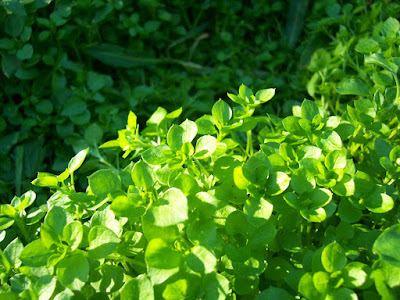
"Oh no!", I hear you say. "Not another contrast picture!" Yes, this is yet again a photo which has two contrasting sections of colour. I found this photo when I was walking around the yard, everything is so lush and beautiful right now after the recent rain - just the right time to get a close-up of what seems to be the Creator's favourite colour - Green.
This photo could be said to use a diagonal variation of the "rule of thirds," as the illuminated, lighter weeds occupy about two thirds of the picture, and the darker, shaded weeds the other third. Notice how the sharp distinction between light and dark even within the lighter section itself helps to break up the monotony of an all-green picture.
Note: For the Americans out there, this title would be spelt "Green is God's Favorite Color"
This photo taken with the Kodak C330 camera.
Related Photos:
The Glory of the Morning (Sun breaking over vine stem)
A Sign of Contradiction 2 (Dead Leaves with Clover)
Odd One Out - Camphor-laurel leaves in contrast
Monday 16 July 2007
The Glory of the Morning [Sun Breaking over Vine Stem]

This indeed is a glorious shot. The rising sun is just peeking it's rays past the shining edge of a Balloon Vine stem, highlighting the fine hairs running along the side of the stem. The rainbow shower of light falling from the contact point shines out over the lavender flowers in the background, and the green leaves at the sides of this magnificent photo complete the image. This image has to be seen to be fully appreciated.
The structure of this image roughly follows the popular "rule of thirds" approach, placing an imaginary grid over the picture to determine the placement of the primary features. The contact point between sun and stem occurs about two-thirds of the way up the picture, and the green leafy frame occupies about a third of the horizontal space on either side. The weighting of this photo is obviously toward the top, with the bright contact point in the center of that region being the main feature of the photo.
This photo taken with the Kodak C330 camera.
Related Photos:
Balloon Vine Flower with Water Droplets
Prickle Resting on a Leaf - A sign of Contradiction

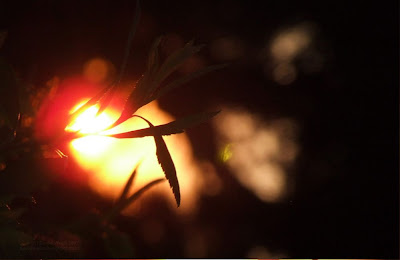
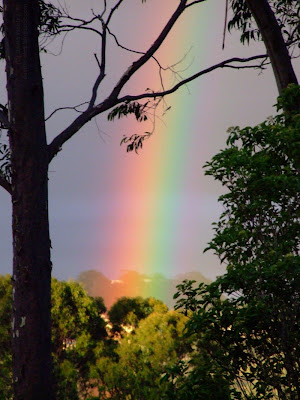



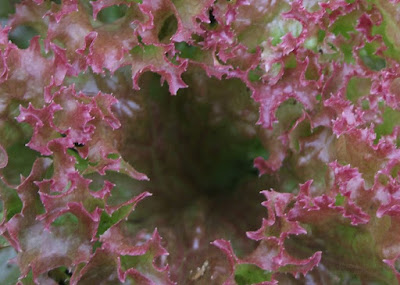




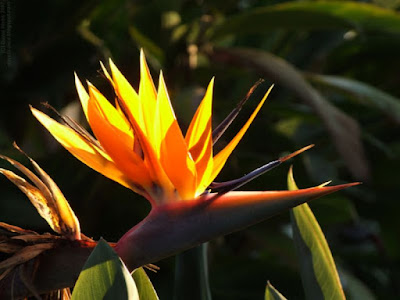 Bird of Paradise Flower
Bird of Paradise Flower